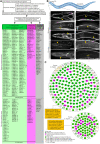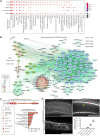A basement membrane discovery pipeline uncovers network complexity, regulators, and human disease associations
- PMID: 35584218
- PMCID: PMC9116610
- DOI: 10.1126/sciadv.abn2265
A basement membrane discovery pipeline uncovers network complexity, regulators, and human disease associations
Abstract
Basement membranes (BMs) are ubiquitous extracellular matrices whose composition remains elusive, limiting our understanding of BM regulation and function. By developing a bioinformatic and in vivo discovery pipeline, we define a network of 222 human proteins and their animal orthologs localized to BMs. Network analysis and screening in C. elegans and zebrafish uncovered BM regulators, including ADAMTS, ROBO, and TGFβ. More than 100 BM network genes associate with human phenotypes, and by screening 63,039 genomes from families with rare disorders, we found loss-of-function variants in LAMA5, MPZL2, and MATN2 and show that they regulate BM composition and function. This cross-disciplinary study establishes the immense complexity of BMs and their impact on in human health.
Figures








Comment in
-
Comprehensive analysis of prognostic and immunological role of basement membrane-related genes in soft tissue sarcoma.Immun Inflamm Dis. 2024 Oct;12(10):e70037. doi: 10.1002/iid3.70037. Immun Inflamm Dis. 2024. PMID: 39392257 Free PMC article.
References
-
- Jayadev R., Sherwood D. R., Basement membranes. Curr. Biol. 27, R207–R211 (2017). - PubMed
MeSH terms
Substances
Grants and funding
LinkOut - more resources
Full Text Sources
Other Literature Sources
Molecular Biology Databases
Research Materials

